Welcome to our Foundations of Food series – where you can get comprehensive, beginner-friendly guides to the foundations of nutrition, to help you make better, more informed choices about your health.
Fats have often been considered the enemy of a healthy diet. But like carbs, they’re often misunderstood. Not all fats are bad for you. In fact, healthy fats are an essential component of a well-balanced diet.
In this comprehensive guide, the second of our Foundations of Food series, we will unpack everything about fats – the difference between ‘good’ fats and ‘bad fats’, MUFA v/s PUFA, fats and their link to heart health. By the end of this guide, you’ll have a clearer understanding of what fats are, and how to incorporate them in your diet in a way that benefits your health.
What are fats and why do we need them?
Fats are part of the three basic macronutrients (the nutrients your body needs in large quantities for its daily functions) – along with protein and carbs. They are the body’s richest source of energy, providing more than double the energy per gram compared to carbohydrates or proteins.
Fats also play a critical role in cushioning your organs, supporting cell growth and the absorption of vitamins. Depending on their chemical structure, fats can be divided into saturated, unsaturated and trans fats.
Saturated v/s unsaturated fats – what’s the difference?
Saturated fats: Chemically speaking, these are fats that are tightly packed, which means they are solid at room temperature. They are mostly found in animal-based products like meat, dairy (whole milk, cheese, butter), eggs, coconut and palm oil.
Unsaturated fats: These are fats that liquid at room temperature. Depending on their chemical composition, unsaturated fats can be further divided into:
- Monounsaturated fats (MUFA): When you dig into your avocado toast, or pour olive oil on your salad – you’re consuming MUFA or monounsaturated fats. These are mostly found in plant-based foods and oils like olive oil, peanut oil, nuts and seeds, avocados, etc.
- Polyunsaturated fats (PUFA): You might have heard the term ‘Omega-3 fatty acid’ and heard that it’s good for you. Omega-3 and Omega-6 fatty acids make up polyunsaturated fats. These are fats that are found in fatty fish, flaxseeds, walnuts, soybeans, sunflower seeds and chia seeds. Omega-6 fatty acids are found in many of the cooking oils we consume, like sunflower, soybean, corn oil, and in foods like walnuts.
The important thing to note is that PUFA are essential fats that your body needs for vital functions like muscle movement and blood clotting, but – most importantly- your body doesn’t produce these fats – it gets them through your diet.
What exactly are trans fats?
Trans fats are a type of unsaturated fat that is artificially produced through a process called hydrogenation – which turns healthy oils into solids. This process was popularized in the early 20th century by the food manufacturing industry to keep food from becoming rancid – hydrogenating unsaturated fats meant they had a longer shelf life. While it was originally used for shortening or margarines, nowadays with the processing industry boom – trans fats can be found lurking in practically all kinds of packages and processed foods from cookies to chips.
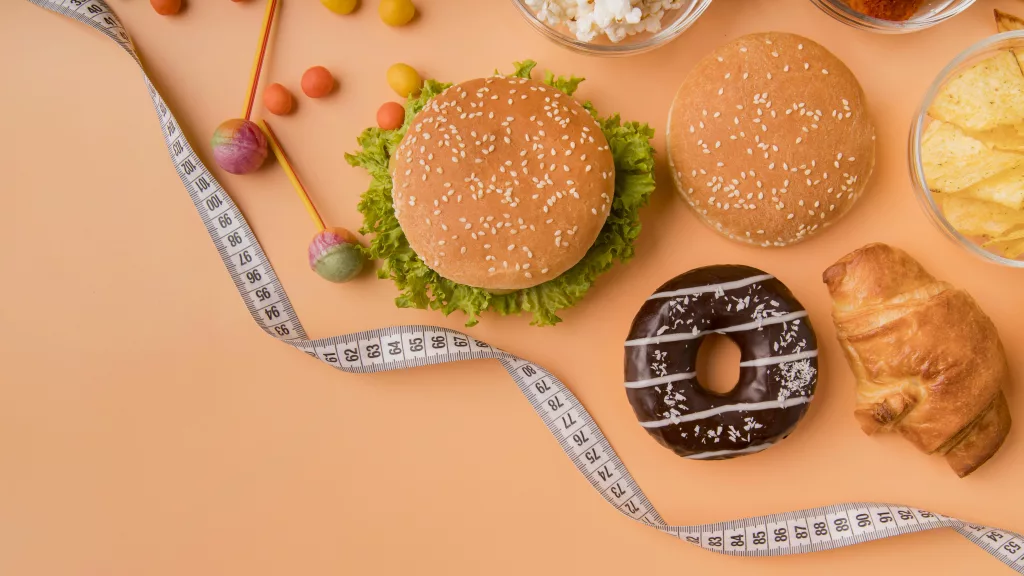
So which fats are ‘good’ and which are ‘bad’?
While the research on ‘good fats’ and ‘bad fats’ is complex, here are the basics:
Trans fats are bad for you
Trans fats, the kind that’s found mostly in processed foods, are the worst kind of fats to include in your diet. If you’ve heard that fats are bad for you – you’re most likely hearing about trans fats. Eating foods rich in trans fats increase the level of ‘bad’ (LDL) cholesterol in your bloodstream, and lower the levels of the ‘good’ (HDL) cholesterol. They have also been linked to heart disease and type 2 diabetes.
Unsaturated fats are good for you
If you’ve read that fats are ‘good’ for you, you are most likely reading about unsaturated fats. Both MUFAS and PUFAs are good for you – and are known to be beneficial for heart health, reducing ‘bad’ cholesterol levels and improving cell growth.
Unsaturated fats are good for you in many ways. They can improve:
- Heart Health: by lowering bad cholesterol levels and increasing good cholesterol levels. Foods rich in omega-3 fatty acids, like fatty fish, flaxseeds, and chia seeds, can lower triglyceride levels and prevent the formation of blood clots.
- Brain Function: Unsaturated fats play a crucial role in brain function. They are essential for the growth and development of the brain, and can also improve cognitive function. Omega-3 fatty acids, in particular, have been linked to a reduced risk of depression, anxiety, and dementia.
- Energy Levels: Unsaturated fats are a rich source of energy and can provide sustained energy throughout the day. They can also help in controlling hunger and reducing food cravings.
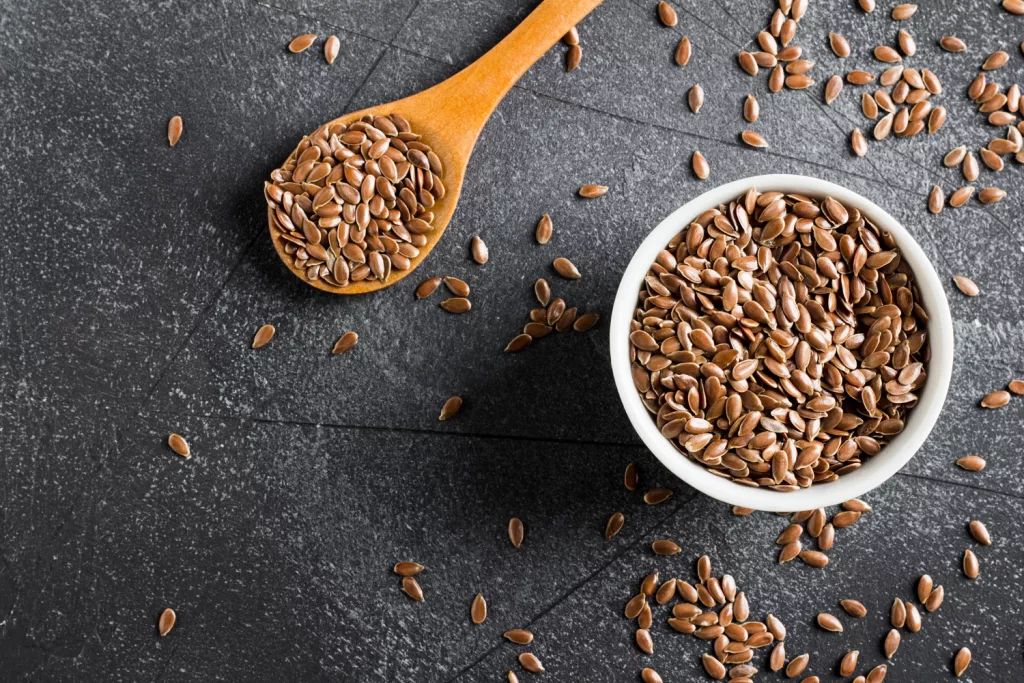
Moderate saturated fats in your diet
Saturated fats – that are typically found in animal products, such as red meat and dairy products – are best consumed in moderation, since research has found that a diet rich in saturated fats can increase your overall cholesterol levels and reduce insulin sensitivity. The National Institute of Nutrition recommends that intake of saturated fats should not exceed 8-10% of your total calorie consumption.
However new research has found no direct linkage between saturated fats and heart disease. That said, where you get your saturated fat from matters. A diet high in saturated fats from fast food or processed/fried food can affect your health differently than a diet high in saturated fats from dairy (milk, cheese, butter) or meat. But even though saturated fats are not necessarily bad for you, replacing saturated fats with unsaturated fats might be healthier in the long run in protecting against heart disease and can also aid with weight loss.
Choosing Healthy Fats in Your Diet
As with carbs, don’t believe the myth that all fats are bad for you. The kind of fats you choose to incorporate in your diet is key. Here are some ways you can increase your healthy fat consumption:
Add more nuts and seeds in your diet
Nuts and seeds are excellent sources of healthy fats, fiber, and protein. They are rich in monounsaturated and polyunsaturated fats that can lower cholesterol levels and reduce the risk of heart disease. Aim to have 4 to 6 servings of unsalted nuts a week, and choose raw/dry-roasted and unsalted ones. You can also add them to your salads, or smoothies, or eat them as a snack between meals.
Here are some healthy fat swaps you can try:
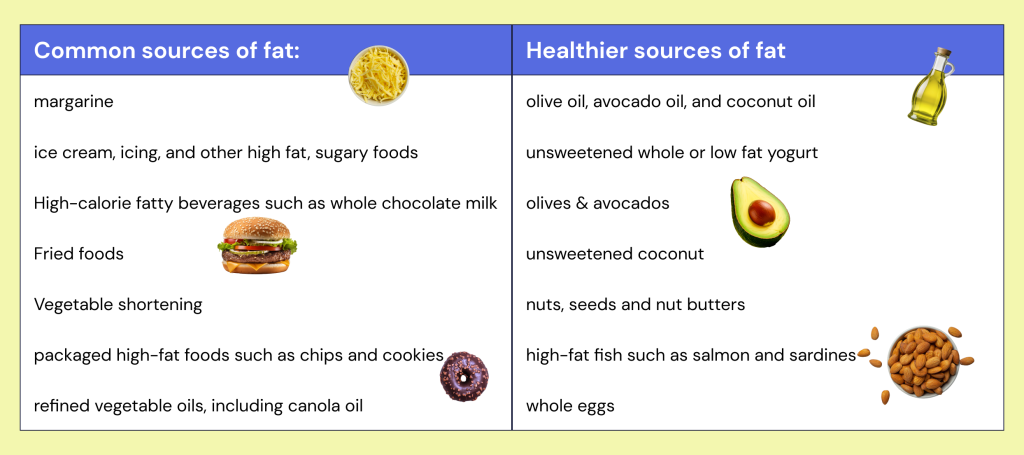
Have more fatty fish
Fatty fish like salmon, tuna, and mackerel are rich in omega-3 fatty acids. These healthy fats can lower blood pressure, reduce inflammation, and improve heart health. Eating fatty fish twice a week can provide the recommended amount of omega-3 fatty acids.
Avoid trans fat
Trans fats can sneak into a bunch of the processed foods that you eat – remember to check the nutrition facts label to ensure that there’s 0 g trans fats in your food. In fact, it’s even better to check for ‘partially hydrogenated oils’ in your ingredients list – since those usually refer to trans fats.
Rotate your cooking oils
The National Institute of Nutrition, India, suggests rotating your cooking oils to ensure that you get a good combination of different types of MUFA and PUFA in your diet. Plus, some oils are rich in Omega 3 fatty acids, while others are rich in Omega 6 and a good balance between these two essential fatty acids are required in your diet.
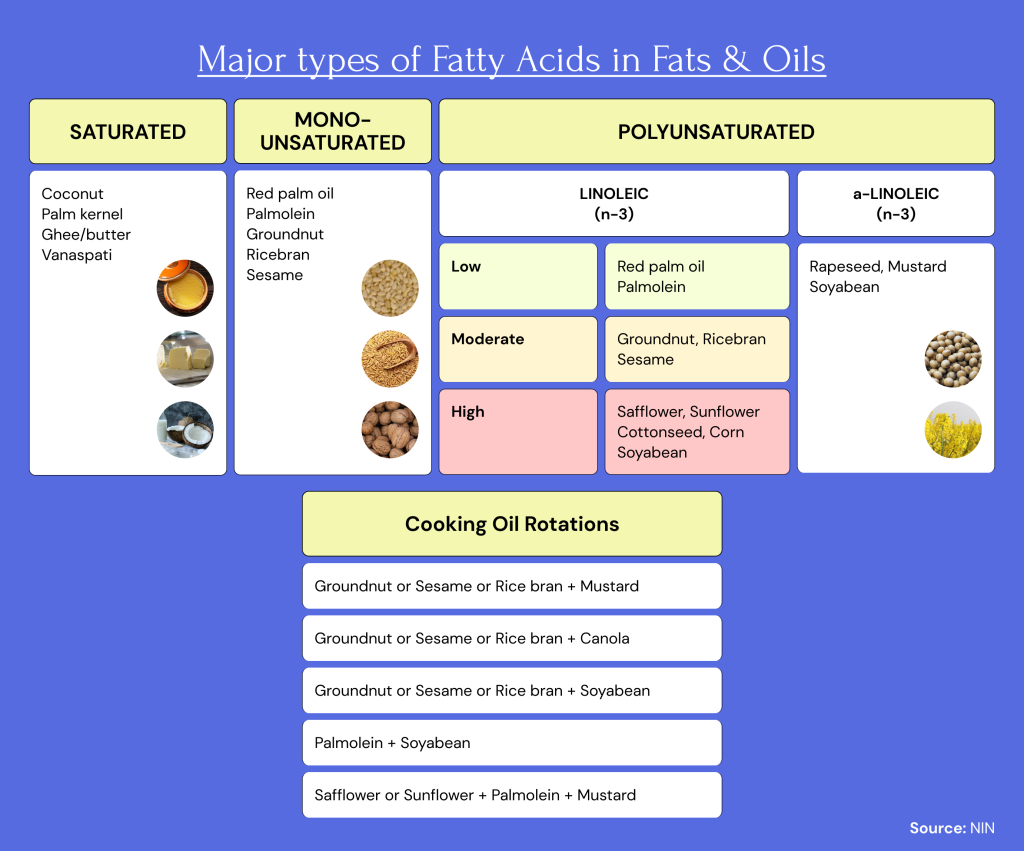
Common questions about fats, answered
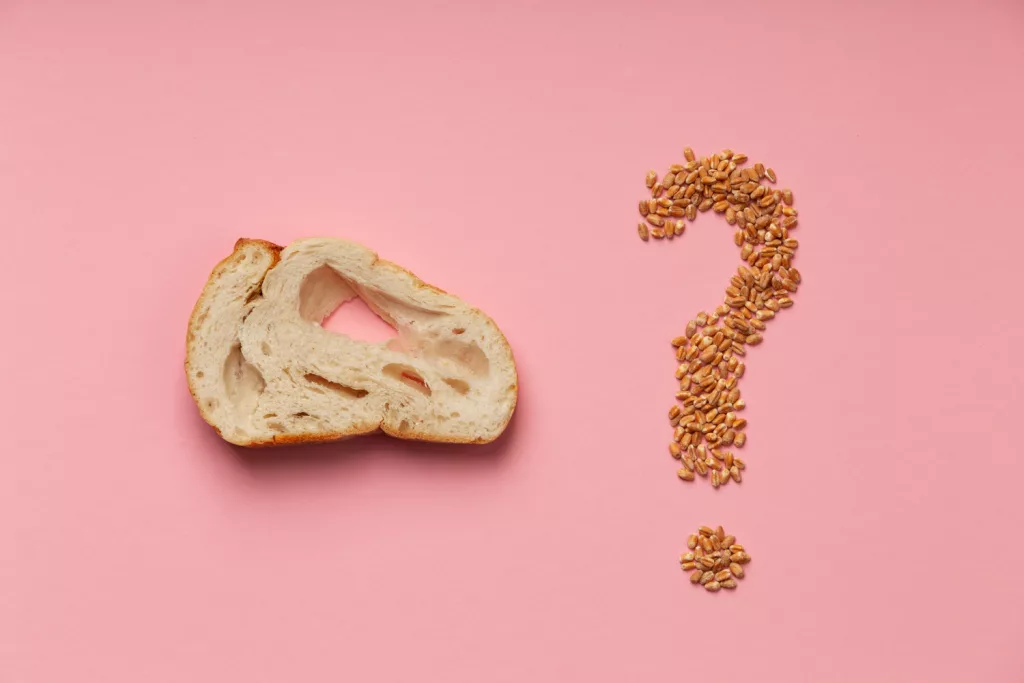
Is it safe to reuse cooking oil?
Reusing cooking oil, particularly after frying, can pose health risks. Each time oil is heated, it undergoes oxidation and releases harmful compounds. Repeatedly heated oil can increase the concentration of these compounds, potentially leading to health issues like heart disease and inflammation. In case of reusing oil, FSSAI (Food Safety and Standards Authority of India) recommends using it a maximum of three times to avoid the formation of trans fat.
Is fried food bad for you?
Regular consumption of fried foods has been linked to various health problems, including an increased risk of heart disease, type 2 diabetes, and obesity. Fried foods are often high in trans fats, depending on the type of oil used and the frying method. These factors contribute to higher bad cholesterol levels and lower good cholesterol, impacting overall cardiovascular health.
Fats from takeout v/s eating at home – which is healthier?
Fats from takeout foods are often less healthy than those from home-cooked meals. Many takeout options tend to use lower quality oils, which may contain higher amounts of unhealthy saturated and trans fats. Home cooking allows for more control over the type and amount of fat used, enabling a healthier preparation with better quality fats like olive oil.
Are fats related to insulin sensitivity?
Dietary fats can have an impact on insulin sensitivity, which is crucial for controlling blood sugar levels. Unsaturated fats, particularly those found in olive oil, nuts, and fatty fish, have been shown to improve insulin sensitivity. Conversely, diets high in saturated and trans fats can worsen insulin resistance, a condition where the body’s cells don’t respond effectively to insulin, leading to higher blood sugar levels and increased risk of type 2 diabetes. Including healthy fats in the diet and minimizing the intake of unhealthy fats is important for maintaining good insulin sensitivity.
How much fat is it safe to consume in a day?
The recommended amount of fat consumption varies depending on your total daily calorie intake and individual health needs. Generally, fats should constitute about 20% to 35% of your total daily calories. For an average adult with a 2,000 calorie diet, this equates to about 44 to 78 grams of fat per day. But it’s important to focus on the type of fat consumed. Opt for unsaturated fats found in foods like nuts (almonds, walnuts), seeds (flaxseeds, sunflower seeds), fish (such as mackerel, sardines), and oils (mustard, rice bran, and groundnut oil). Limit the intake of saturated fats, which are common in butter, ghee, and high-fat dairy products. Avoid trans fats and vanaspati as much as possible. However, for advice on how much fat is safe to consume given your lifestyle needs, it’s important to consult an nutritionist.
Takeaway
Remember, not all fats are bad for you, and healthy fats are an essential component of a balanced diet. Choosing the right fats are key to helping make sure your body has all the nutrients it needs.




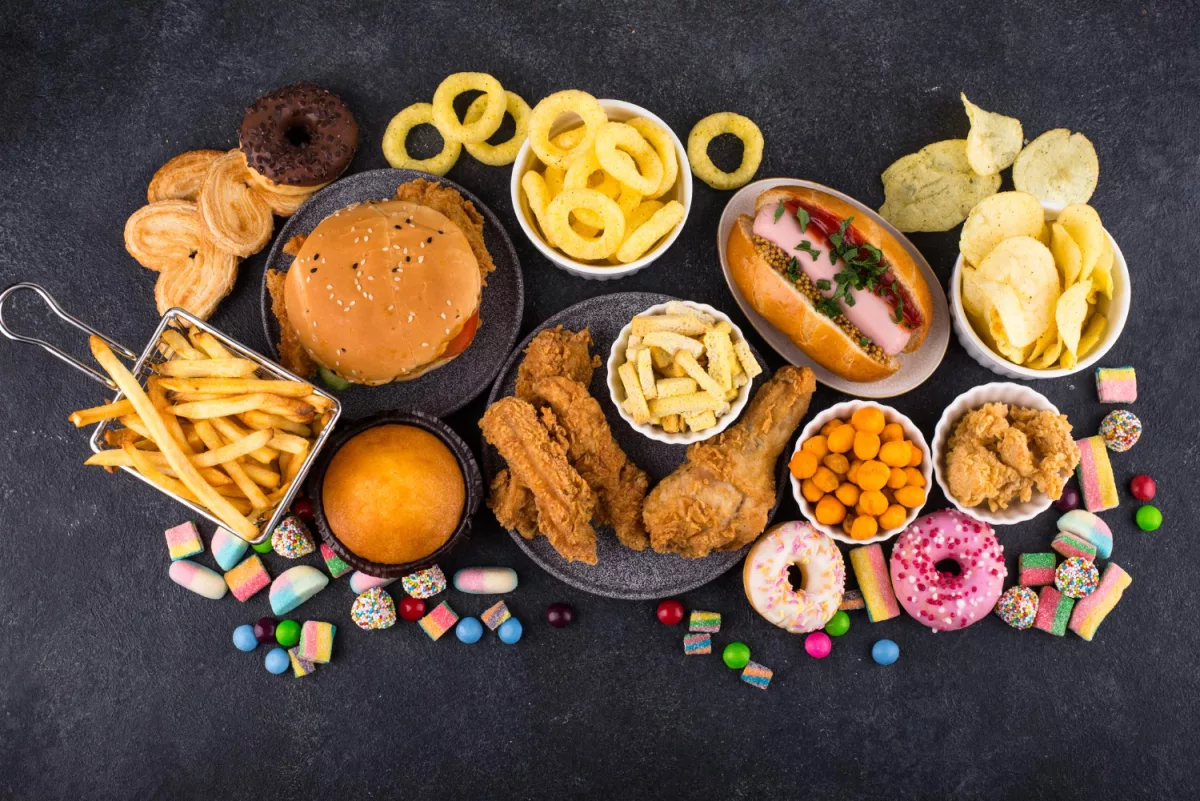


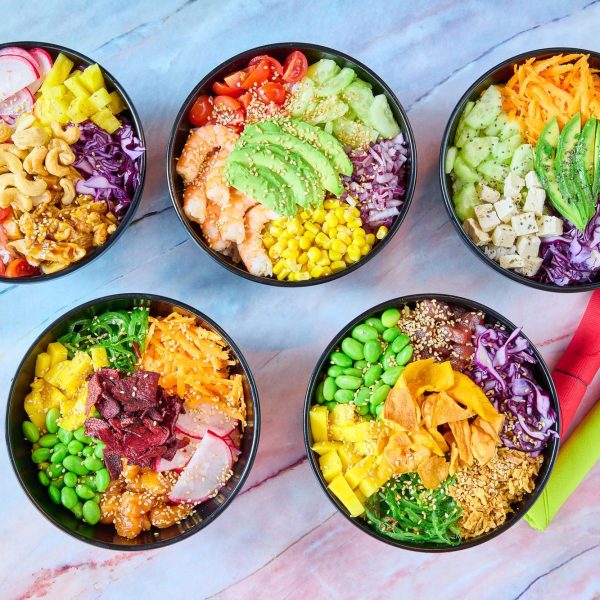










Share this article